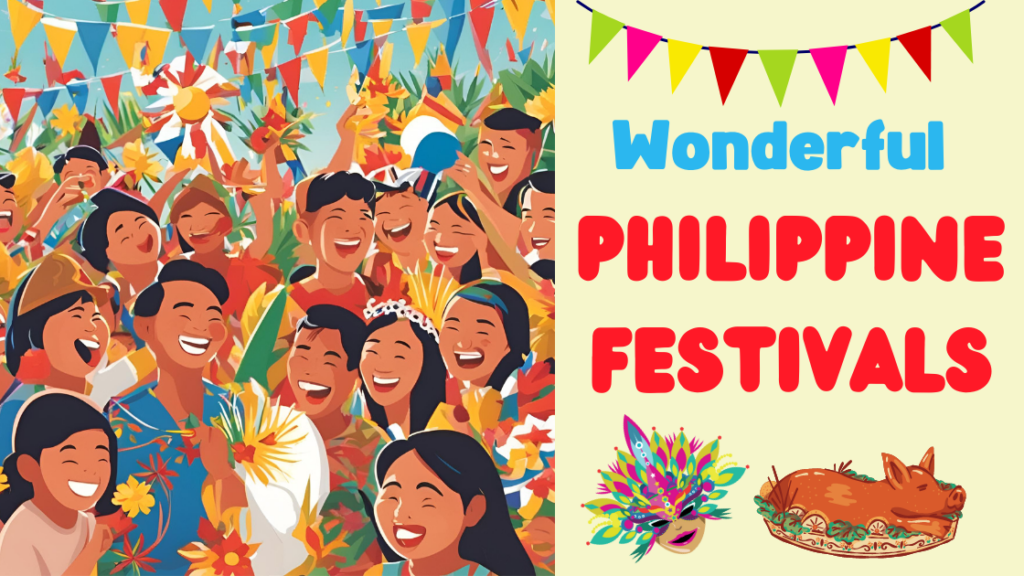The Philippines is renowned for its vibrant and colorful festivals, each reflecting the rich cultural heritage and diverse traditions of the archipelago.
One of the most famous is the Sinulog Festival in Cebu, celebrated every January in honor of the Santo Niño (Holy Child). The festival features a grand parade with participants in elaborate costumes dancing to the rhythm of drums and native gongs.
Another notable festival is the Ati-Atihan in Kalibo, Aklan, also in January, which pays tribute to the Santo Niño but has roots in the indigenous Ati people. Participants paint their faces with black soot and wear indigenous-inspired costumes as they dance through the streets.
Pahiyas Festival in Lucban, Quezon, celebrated every May, is a thanksgiving event for a bountiful harvest where houses are decorated with colorful kiping (rice wafers) and agricultural produce.
These festivals, among many others, showcase the Filipinos’ deep sense of community, faith, and joyous spirit.

The Philippines is renowned for its vibrant festivals, which reflect its rich culture, history, and traditions. Here are some of the most popular festivals in the country, along with their locations and brief histories:
Sinulog Festival
- Location: Cebu City, Cebu
- History: Held every January, Sinulog honors the Santo Niño (Child Jesus). It traces its roots to a pre-Hispanic native dance that was later adapted to Christian practices. The festival features a grand street parade with participants in traditional Visayan attire dancing to the beat of drums.
Ati-Atihan Festival
- Location: Kalibo, Aklan
- History: Held in January, Ati-Atihan honors the Santo Niño and is one of the oldest festivals in the Philippines. It is believed to have been celebrated since the 13th century, featuring participants painting their faces with soot and dancing in the streets.
Pahiyas Festival
- Location: Lucban, Quezon
- History: Celebrated in May, Pahiyas is a harvest festival that dates back to Spanish colonial times. Locals decorate their homes with colorful and creative displays made of agricultural products as an offering of thanks for a bountiful harvest.
Kadayawan Festival
- Location: Davao City, Davao del Sur
- History: Taking place in August, Kadayawan celebrates the cultural heritage of the Davao Region, showcasing its indigenous tribes, floral floats, and street dancing. The festival highlights the region’s rich history and its natural resources
Panagbenga Festival
- Location: Baguio City, Benguet
- History: Panagbenga, or the Flower Festival, takes place in February. It started in 1996 to revive Baguio’s tourism after the 1990 earthquake. The festival is known for its grand parade of flower-decorated floats and street dancing.
Hala Bira Festival
- Location: Pavia, Iloilo
- History: Held in July, this festival honors the patron saint San Juan Bautista with street dancing, cultural performances, and traditional games, reflecting the local community’s spirit.
Giant Lantern Festival
- Location: San Fernando City, Pampanga
- History: Held in December, this festival showcases gigantic lanterns made of colorful materials. It started as a simple Christmas decoration event and has grown into a grand display of creativity and craftsmanship.
Bamboo Organ Festival
- Location: Las Piñas City, Metro Manila
- History: Celebrated in February, this festival centers on the Bamboo Organ, a unique instrument built in the 19th century. It includes concerts and cultural events showcasing the organ’s historical and musical significance.
Flores de Mayo
- Location: Nationwide
- History: Held throughout May, Flores de Mayo is a Catholic tradition celebrating the Virgin Mary with daily floral offerings and processions. It culminates in the Santacruzan, a grand procession featuring a parade of women in traditional Filipino attire.
The list just covers the tip of the ice berg, for almost each town, city and province here in the Philippines has their own festival, and its your job to visit them all!!!!
VIVA…. VIVA!!!!